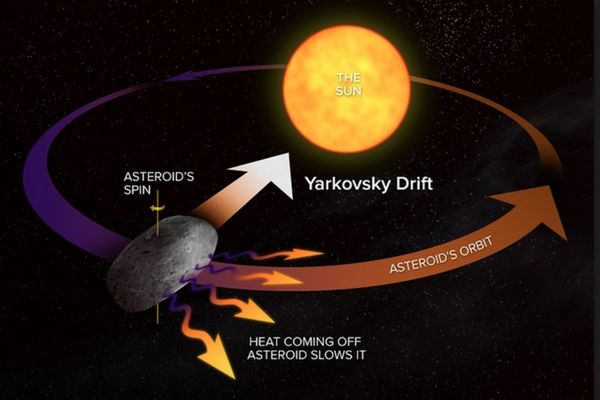Predict the path of an object in orbit
Build a simple orbital simulator using a string, a small ball, and cardboard to model gravity and predict how an object travels in orbit.



Step-by-step guide to predict the path of an object in orbit
Scientists track fast-moving object approaching Earth | Newsmaker | FOX 10 Phoenix
Step 1
Gather all the materials on a clear table so you can build easily.
Step 2
Use the ruler and marker to draw a circle about 20 centimeters across on the cardboard.
Step 3
Cut out the circle carefully with scissors to make your simulator base.
Step 4
Make a small hole in the exact center of the cardboard using the pencil point.
Step 5
Push the pencil through the hole so the pencil pokes out underneath the cardboard.
Step 6
Tape the pencil under the cardboard so the pencil stands upright and will not fall out.
Step 7
Tie one end of the string tightly to the small ball so the knot will not slip.
Step 8
Thread the free end of the string up through the hole so the ball hangs below the cardboard.
Step 9
Hold the pencil upright steady with one hand so it does not wobble.
Step 10
With your other hand give the ball a gentle circular push so the string wraps and the ball orbits the pencil.
Step 11
Point to or say where you think the ball will fly if you let go while it is orbiting to make a prediction.
Step 12
Let go of the ball while it is moving and watch the exact path it takes through the air.
Step 13
Pull more string through the hole to make a longer orbit or pull the ball closer to make a shorter orbit to change the orbit radius.
Step 14
Release the ball again after you change the length and watch how the path is different from your first try.
Step 15
Take a photo or draw your setup and results and share your finished orbital simulator and what you learned on DIY.org
Final steps
You're almost there! Complete all the steps, bring your creation to life, post it, and conquer the challenge!


Help!?
What can I use instead of a pencil or the small ball if I don’t have them?
Use a wooden dowel, thick marker, or BBQ skewer in place of the pencil pushed through the center hole and taped under the cardboard, and replace the small ball with a crumpled foil ball, ping-pong ball, or large bead tied to the string as in the step 'Tie one end of the string tightly to the small ball'.
The ball keeps hitting the table or the pencil wobbles — how do I fix that?
If the pencil wobbles or the ball hits the table, make the center hole smaller, push the axle further through and tape it flat under the cardboard so the pencil stands upright steady, and shorten or raise the orbit by pulling less string as described in 'Make a small hole...', 'Tape the pencil under the cardboard...', and 'Pull more string through the hole...'.
How can I adapt this activity for younger kids or older kids?
For younger children, have an adult pre-cut the cardboard circle and thread the string while the child watches and makes a simple prediction, and for older kids have them use the ruler to measure orbit radii, record photos or times after each 'Release the ball', and analyze how changing the string length alters the path as in 'Use the ruler and marker...', 'Release the ball...', and 'Pull more string...'.
How can we extend or personalize the orbital simulator once it’s working?
Extend the activity by marking concentric rings on the cardboard with the ruler and marker to test specific orbit radii, attaching a small colored flag or sticker to the ball to visualize its trajectory, and documenting differences with photos or drawings as suggested in 'Pull more string...' and 'Take a photo or draw your setup and results'.
Watch videos on how to predict the path of an object in orbit
How Do Scientists Track Asteroids And Comets? - Astronomy Made Simple
Facts about orbital mechanics for kids
🌍 A satellite in low Earth orbit travels about 7.8 km/s — roughly 28,000 km/h, so orbits are really fast!
🧲 Gravity is the invisible pull that keeps the Moon orbiting Earth at an average distance of ~384,400 km.
🔄 In your string-and-ball simulator, the string's tension plays the same role as gravity by providing centripetal force.
🎯 Kepler's laws show planets sweep out equal areas in equal times, so they speed up when closer to the Sun.
🚀 To leave Earth entirely you'd need about 11.2 km/s (escape velocity); staying in orbit needs less sideways speed.
How do I build and use a simple orbital simulator with a string, a small ball, and cardboard to predict an object's path?
What materials do I need to make this DIY orbital simulator?
What ages is this orbital simulator activity suitable for?
What are some fun variations to extend the orbital simulator experiment?


One subscription, many ways to play and learn.
Only $6.99 after trial. No credit card required


